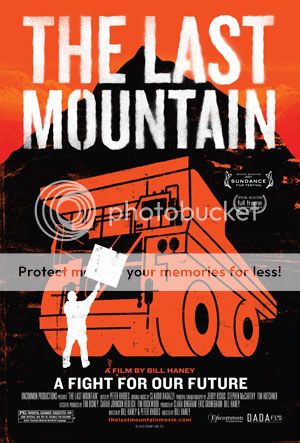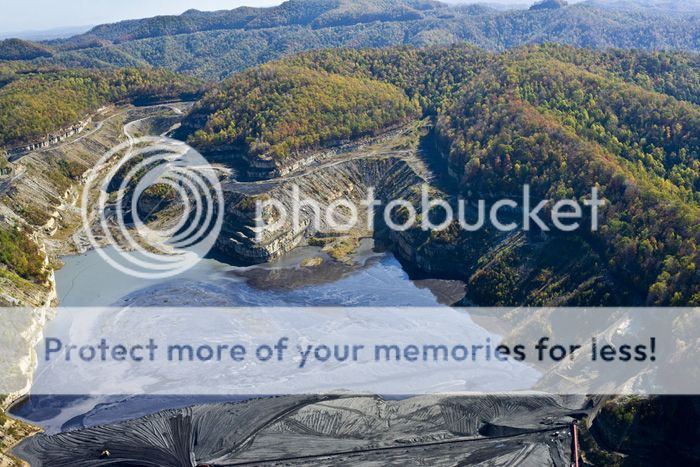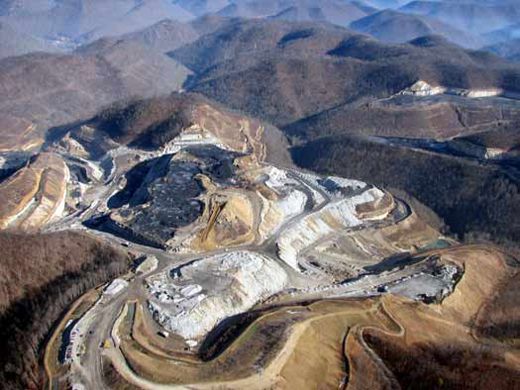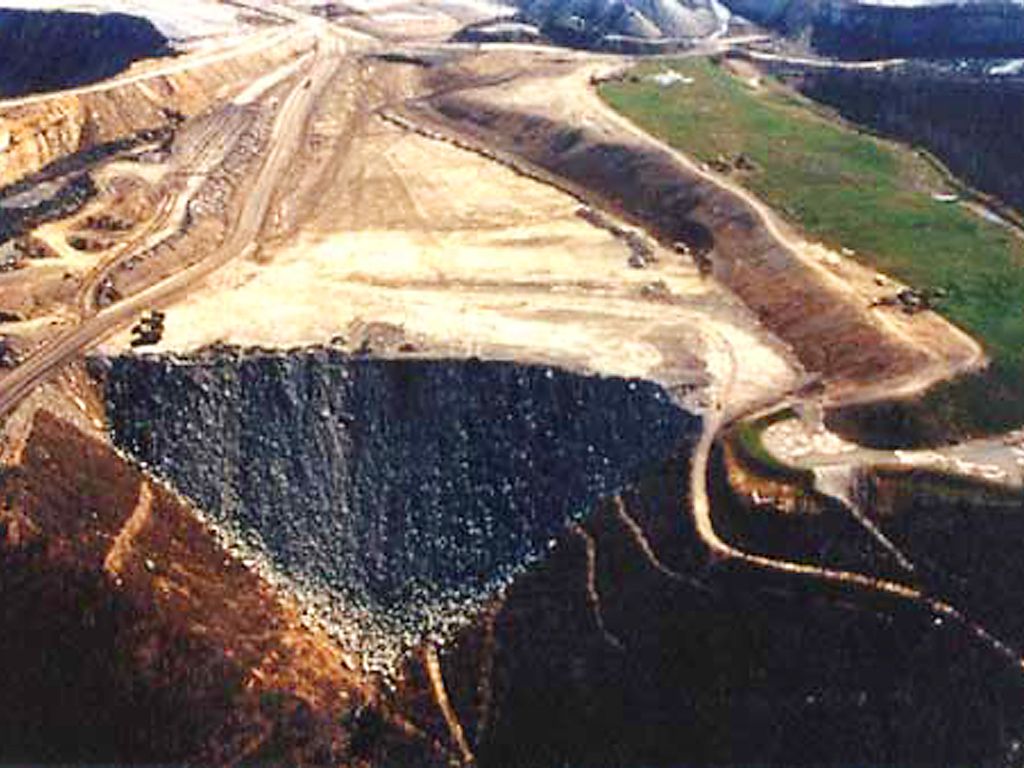
About a year ago, a little publicized, unheralded documentary named Mountaintop Removal (which ScriptPhD.com reviewed) attempted to deconstruct the environmentally devastating practice of the same name literally destroying the Appalachian geography of West Virginia’s coal river valley. Honest, yet modestly shot and produced, the small-scale documentary needed a Hollywood touch to resonate on a human level to advance its powerful cause. It got what it needed in The Last Mountain, a celebrated selection of this year’s Sundance Film Festival. This important new documentary succeeds in both relaying the urgency of a destructive coal mining practice that is literally zoning in on one last undamaged mountain as well as forging a human connection with the townspeople battling to save it. Full ScriptPhD.com review under the “continue reading” cut.
Most people don’t think twice about where the electricity for their light bulbs comes from. Or if they know it primarily comes from coal, they are not aware of how that coal comes to see the light of day. In the valleys and mountaintops of idyllic Appalachia, the coal industry detonates the explosive power of a Hiroshima bomb every week, utilizing a crude process called mountaintop removal. There is nothing scientific or technical about mountaintop removal. It is crude, cruel and its effects non-reversible. First, trees and other natural ecology are removed from the tops of mountains. Then, dynamite splits the mountain open to unearth a layer of coal that is mined by brave men risking their lives in ungodly working conditions. When the layer is depleted, the next layer is blasted, until nothing is left but a hollow shell of a devastated mountain. In its wake, the process leaves behind toxic sludge piles containing arsenic, lead and mercury, contaminated rivers and streams, fine particulate airborne matter that creates an epidemiological health nightmare, and unlivable communities. Mountaintop removal has already destroyed 500 Appalachian mountains, decimated 1 million acres of forests, and buried 2,000 miles of streams.
Take a look at a clip from The Last Mountain that shows the destruction from an aerial view:
In the beautiful mountains of the Coal River Valley in West Virginia, mining corporations such as Massey Energy are blasting the mountains of Appalachia into extinction, polluting the air and water with blithe impunity, and amassing the kind of profits that allow them to wield massive lobbying power in Washington, DC to both repeal existing environmental regulations and obviate the ratification of new ones. One small community has had enough. Their only schoolhouse sits at the base of a silo where 28 million gallons of toxic sludge left over from the coal mining are held back by a flimsy levee. Their neighbors and friends—ranging from 5 to 63 years old to—are dying in masses from strange tumor clusters. Water filters that should last 3-4 months get plugged up after two weeks. The very last mountain in Coal River, protecting the community from massive flooding after rainfall, is being targeted for blasting. And that is when the people of Coal River decide to fight back.
The Last Mountain is not just a standard environmental cautionary tale, but also an uplifting tale of citizens taking back their community. Helping the cause is noted environmentalist Robert F. Kennedy, Jr., who travels to Coal River, aligns with the community, and attends dozens of rallies that are held to protest the actions of Massey Energy. In one of the film’s lighter moments, a humble West Virginian remarks “I never thought I’d have a Kennedy in my living room!” It is these very human moments that ultimately connect the audience to a cause seemingly unrelated to our lives. The most poignant moment of The Last Mountain is live footage of Coal River residents that had traveled to the governor’s offices in Charlotte to present him with money raised through a local Pennies For Promise campaign to build a new, safer schoolhouse (an ultimately successful initiative.) At first the governor is touched, even amused, by the rural denizens. But when they bring up the actions of Massey Energy, and the governor’s own futility in stopping the damage to their community, he is stunned, even embarrassed, even going so far as to have the West Virginia government arrest the protesters—one of whom was a 91-year-old woman in a flag-draped wheelchair. “Why are our kids any different?” former Massey Energy contractor turned activist Ed Wiley shouts at the governor. “Because they’re in the coal fields? They’re on the wrong side of the mountain?”
If you think this movie, or mountaintop removal itself, doesn’t affect you, you’re wrong. Almost half of the electricity produced in the US comes from the burning of coal (that’s 16 pounds of coal each day for each man, woman, and child!). 32% of that coal comes from…you guessed it…the mountains of Appalachia. It also happens to be the #1 sources of greenhouse gases worldwide. And it doesn’t stop there. The toll on health from the burning of coal nationwide—contributing to such problems as 10 million asthma attacks, brain damage in newborns and thousands of premature deaths—adds up to $345 billion annually. We are all paying the cost of mountaintop removal in one way or another. You’re connected to coal, whether you realize it or not.

As The Last Mountain eventually conveys, this is a tale about so much more than blasting off a mountain—it’s about hubris and powerful people thinking they can do whatever they want, while destroying lives in the process. How’s this for a silent statistic? Massey Energy’s 28 impoundments have spilled 24 times in the last decade, contaminating rivers with 300 million gallons of sludge—that is twice the amount released in the BP oil spill in the Gulf that shocked the world. After a $28 million dollar settlement for their environmental violations, Massey Energy committed 180 more violations with no impunity. And the tragic thing is that the alternative technology is so much more effective and inexpensive. The filmmakers end with an uplifting visit to Portsmouth, WV, a municipality that supplies ¾ of its electricity needs for the community with two windmills with low-grade Category 2 winds. The winds in the Coal River Valley? The highest possible—Category 5. One can only imagine how many jobs and clean energy could be created from wind turbines in the Coal River Valley. A 1991 Department of Energy study concluded that only three US States, Kansas, North Dakota and Texas, have enough harnessable wind energy to supply the entire nations energy needs. Twenty years later, we have the technology to make it happen.
The ultimate message of The Last Mountain is that is not enough to simply be outraged anymore. We are all users of the electricity and power that is generated from the sacrifices of the Appalachia residents and miners. The imagery of environmental devastation is so shocking, the deregulation and egregious indifference of the coal mining companies’ various violations so appalling, that we begin to feel somehow complicit in perpetrating this modern American tragedy. Fixing it starts with watching documentaries like The Last Mountain, but also in taking the kind of inspiring action as that of the small rural West Virginia community that the film portrays. Ordinary people, banded together in a common purpose, can indeed move mountains. And sometimes, they can even save them.
Trailer:
The Last Mountain was released in limited screenings on June 15th, and goes into theaters nationwide later in June.
~*ScriptPhD*~
*****************
ScriptPhD.com covers science and technology in entertainment, media and advertising. Hire our consulting company for creative content development.
Subscribe to free email notifications of new posts on our home page.
]]>
One of the most pressing issues of our time is how and where we are going to get sustainable energy for a global population with a rapidly rising standard of living and the consumption that this entails. Approximately 10% of United States coal production [coal in general accounts for 40% of global electricity production] is procured through mountaintop removal, an environmentally-devastating extraction that literally involves blasting off (or removing) the top of a mountain to extract the coal inside. The practice gained popularity in the 1960s, when it started becoming too difficult and too costly to extract coal from underground mines. In our continuing “It’s Not Easy Being Green” series, ScriptPhD.com’s eco-blogger Captain Planet talks about the documentary Mountaintop Removal, exactly what it entails, and why this process is so much more costly than the immediate energy gained from it. Please click “continue reading” for more.
“Take away wilderness and you take away the opportunity to be American.” –Roderick Nash, from ‘Wilderness and the American Mind’
If you were wondering where the sets for the land of Mordor were filmed for the Lord of the Rings trilogy, the answer would be New Zealand. But after viewing Mountaintop Removal, a well done, if homely, documentary currently in rotation on PBS and a film festival darling, the answer could just as easily have been a coal mining site in West Virginia.
So begins the story of Mountaintop Removal, with shaky aerial shots of mountains which, as you may have guessed by the name of the film, have had their tops removed. The resulting carnage of mountaintop removal is horrific in its environmental damage, toxic impact on human health, and permanent mutilation of a once-beautiful geography. As the film is quick to point out, you can cut down a forest, and eventually, it could grow back. But when you slice off the top of a mountain and extract all the coal inside, the mountain doesn’t grow back. Ever. What was once idyllic countryside in the Appalachian Mountains is quickly becoming a nightmare of epic proportions. To date, mountaintop removal has destroyed 1,000,000 acres in the Appalachian area.
The dirty secret behind goal is that it comprises 50% of the USA’s energy production. Burning coal is the cheapest way we know of to produce electricity, but it is also the most harmful in terms of the amount of carbon dioxide it produces, hastening the rise of the planet’s thermostat. Jeff Goodell, a coal specialist and author of Big Coal, says in the film that when he first started researching coal, he was surprised that we actually still use it today. He thought it had gone the way of the horse buggy and top hat. “I thought that electricity was just something that flowed down from a golden bowl in the sky. I never gave any thought to where it came from.”
So where does it come from, and how does mountaintop removal work, anyway? The organization Aurora Lights.org has an exceptional collection of information about mining, coal removal and alternative energy, and is a great resource for in-depth information. In essence, the practice of mountaintop removal is a five-part process. It begins with clearing, literally razing, burning and deforesting the trees to provide an unobstructed mining path:

The process continues with blasting, usually involving the use of dynamite to clear away earth and rock above the coal seams. This process in particular releases silica and chemical-ladden dust as airborne
particles to surrounding communities:

Next is the critical step of digging to clear rubble leftover from the blast and expose the coal seams directly for extraction and removal:

The rubble from the denuded mountains is dumped in the next step, called a valley fill, in which tons of rubble are relocated into the mountain’s valleys. This process has buried 1,900 miles of headwater streams (more on this below) and increased flooding during rainfall.

Finally, after all the coal has been mined, the barren mountainside is “replenished” reclamation, a largely superficial aesthetic process that involves planting of grass and plants, most of which will not ultimately be able to survive in the rocky ground.

If any or all of this sounds environmentally devastating, that’s because it is.
The Mountaintop Removal documentary highlights a coalition of concerned citizens who have organized to prevent further coal mining. They are comprised of college students, parents and environmentalists. The film introduces us a small elementary school in West Virginia with a coal mine in its backyard. The school sits next door to a “lake” full of coal slurry (akin to toxic sludge), which includes large volumes of lead, arsenic and cadmium. The children of the school have suffered increased rates of asthma, headaches and mouth sores, to name a few of the most common maladies. In a particularly effective scene, the parents of these school children march into the governor’s mansion unannounced and ask the Governor to relocate their children’s school to an area away from the coal mines.
The underlying issue of coal production is at the heart of our nation’s energy policy. As one interviewee so succinctly puts it in the film, we are at a crossroads where we must decide if we’re going to convert to sustainable,
green sources or continue pursuing non-renewable sources that pollute the environment and contribute to global warming. If you’ve been watching any television episodes on Hulu lately, you may have come across an advertisement for Coal River Wind. It’s a movement underway to install a fleet of wind turbines on the side of Coal River Mountain in West Virginia. It’s a race against time because Massey Energy (contact them today!), the lead coal company featured in Mountaintop Removal, has filed permits to remove the mountaintop which would destroy the wind potential. The Coal River Wind website urges visitors to write to the EPA, sign their petition and donate. It’s a microcosm of the country’s political will and long-term energy policy.
The most effective point that Mountaintop Removal ultimately makes is one of sustainability. Once the mountain ranges of Appalachia have been stripped of all coal, the coal companies will move on to other areas or dissolve. What they will leave in their wake will be broken economies, blighted landscapes and a host of health problems for anyone who is still living in the area, effectively turning the Appalachians into something like a modern-day dust bowl.
The scientific consensus on mountaintop coal mining is stunningly clear. Last month, an analysis of collected scientific studies concluded in the scholarly journal Science that mountaintop coal mining is deleterious to both the environment and human health and should be banned altogether. In all, this coal extraction process has filled 700 miles of US streams with debris, sludge and toxic pollution. Sadly, President Obama’s recent compromise with the Patriot Coal Company will steamroll [pardon the pun] a major mining project in West Virginia.
Mountaintop Removal trailer:
Websites that you can visit and organizations to get involved in to help stop mountaintop removal mining:
Coal River Mountain Watch
Ohio Valley Environmental Coalition
WV Highlands Conservancy
Mountain Justice Summer
Earthjustice
Photographer George Wuerthner has magnificently documented the ravages of mountaintop mining removal in Kentucky. The jarring mages are enough to implore you to get involved today.
CaptainPlanet is an LA-based, Northwestern University-educated eco-charged sustainability guru who loves film, psychology and saving the planet, one waterless urinal at a time…
~*CaptainPlanet*~
*******************
ScriptPhD.com covers science and technology in entertainment, media and advertising. Hire our consulting company for creative content development.
Follow us on Twitter and our Facebook fan page. Subscribe to free email notifications of new posts on our home page.
]]>
